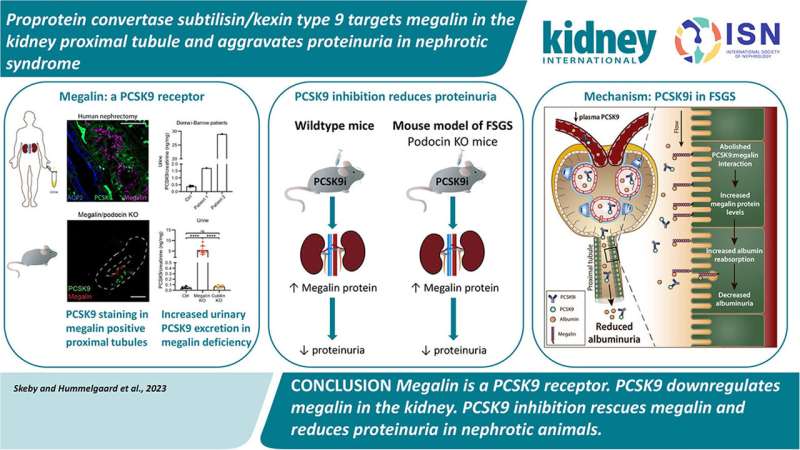This article has been reviewed according to Science X's editorial process and policies. Editors have highlighted the following attributes while ensuring the content's credibility:
fact-checked
peer-reviewed publication
trusted source
proofread
A new mechanism may lead to new treatment options for chronic kidney diseases

Chronic kidney disease is a growing problem both in Denmark and internationally. Now, a new study from Aarhus University reveals that a protein known for treating cardiovascular diseases also counteracts a mechanism in the kidney that reabsorbs proteins. This could potentially lead to new treatment options. The paper is published in the journal Kidney International.
The kidneys are the body's cleansing organs. Their function is to filter the blood, remove waste products and toxins, and release substances such as sugar and amino acids back into the blood. When the kidneys fail, substances accumulate in the body, which can lead to poisoning, fluid retention, and in many cases, cardiovascular diseases with an increased risk of heart attacks and strokes, which are the leading causes of death in Denmark.
In Denmark, over 10% of the adult population lives with chronic kidney disease, and thus also with a significantly increased risk of developing cardiovascular diseases. But now, a new study suggests that the cardiovascular system may open up a new treatment strategy. The researcher behind the study, Associate Professor at the Department of Biomedicine at Aarhus University, Kathrin Weyer, explains:
"We have found that a protein called PCSK9, which influences the cholesterol level in the blood and increases the risk of cardiovascular diseases, has completely new and unexpected effects in the kidneys. In the study, we can see that PCSK9 regulates a receptor in the kidneys that controls the amount of protein excreted in the urine. This knowledge can potentially be used to treat patients whose kidneys are overloaded and therefore have an accumulation of protein in their urine," she says.
In the kidneys, the so-called megalin receptor is central to the reabsorption of filtered proteins, and thus to the amount of protein excreted in the urine. In patients where the receptor no longer functions optimally, the system becomes overloaded, leading to a condition called proteinuria, where there is an abnormally high level of protein in the patient's urine.
Proteinuria is an important indicator of kidney disease and a critical risk factor for developing chronic kidney disease. In the study, it is precisely the megalin receptor and thus the kidneys' efficiency in reabsorbing filtered proteins that PCSK9 appears to negatively regulate.
The medication is already in use
The fact that PCSK9 is a therapeutic target is not new in the medical field. Today, cardiovascular patients worldwide are treated with PCSK9 inhibitors used to lower elevated cholesterol levels. Therefore, it is important to determine whether PCSK9 inhibition can also be used for the treatment of kidney diseases, says Kathrin Weyer:
"Chronic kidney disease is a growing problem both domestically and globally. Therefore, new treatment options are necessary. We demonstrate a new molecular mechanism by which PCSK9 affects the development of proteinuria. This mechanism has not been previously known," she explains.
Associate Professor Kathrin Weyer and the research team now hope to further investigate the use of PCSK9 inhibitors in the treatment of kidney diseases.
"Our study provides a basis for further studies that will examine whether the use of PCSK9 inhibition is beneficial in kidney diseases. If it turns out that it actually enhances treatment, then within a relatively short period, a completely new form of therapy can be offered to kidney patients."
More information: Cecilie K. Skeby et al, Proprotein convertase subtilisin/kexin type 9 targets megalin in the kidney proximal tubule and aggravates proteinuria in nephrotic syndrome, Kidney International (2023). DOI: 10.1016/j.kint.2023.06.024


















